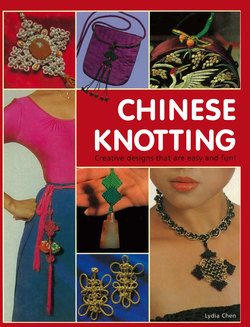Читать книгу Chinese Knotting - Lydia Chen - Страница 6
На сайте Литреса книга снята с продажи.
ОглавлениеPUBLISHER’S FOREWORD
This book introduces readers and crafts people to the fascinating world of Chinese knotting. Sometimes referred to as Chinese macramé, Chinese knotting is a craft increasingly gaining popularity in both the East and the West as more and more people come to realize the benefits of traditional handwork in a world of urban industrialization, mass production, modern transportation, and computer technology. This traditional craft provides not only a wonderful means of relaxation but also allows the artistic satisfaction of producing a personalized work of art.
Chinese knotting, literally “the joining of two cords”, is an ancient and revered art form in China and an integral part of Chinese life. Since ancient times, Chinese knots have been fashioned from cotton and silk for a variety of practical and decorative purposes: to record events, aid in fishing and hunting, wrap and tie items, embellish personal attire, ornament other works of art, and communicate. The earliest recorded use of decorative knots is on bronze vessels dating to the Warring States Period (700 BC). Chinese knots have decorated both the fixtures of palace halls and the daily implements of country folk. They have also appeared in paintings, sculptures, and folk art. In Chinese poetry, knots symbolize the emotional ties of lovers, and ornamental knots are traditional keepsakes exchanged by lovers.
In China, up until the late 1930s, decorative knotting was a widespread pastime. On festive occasions and during important rites of passage such as weddings, intricate and beautiful knots, tied by family and friends, could be seen everywhere, lending both a festive and personal air to important occasions. The knots were an aesthetic expression of Chinese folk symbolism, expressing wishes for good fortune and wealth or the joys of love and marriage.
From the 1930s up until the late 1970s, when the art of macramé became popular in the West - causing a simultaneous revival of interest in Chinese knotting - traditional knotting was barely seen except in museums where examples were shown as relics of an ancient culture or in antique shops where they were greedily snapped up by foreign buyers intrigued by the intricate craftsmanship and the magnificent color combinations of the exquisitely symmetrical knots on sale.
In this book, the author, Lydia Chen, a well-known and highly respected authority on Chinese knotting and a pioneer in the revival of Chinese knotting, first traces the evolution of the craft, piecing together scraps of evidence that have trickled down through research into historical texts, the examination of both archaeological finds and items in public and private collections, and interviews with aged Chinese folk artists.
This knowledge has been assembled in a practical manual that takes readers through the fundamental elements necessary for tying Chinese decorative knots: the materials and implements required, and the processes of tying, tightening, and adding the finishing touches to knots. There are step-by-step instructions for the eleven basic knots, which are named according to their distinctive shapes, use, or origins. The double coin knot, for example, shaped like two overlapping coins of the type once used in ancient China, is regarded as a symbol of prosperity and was once hung by merchants over their shops to attract wealth. The pan chang or mystic knot, one of the eight Buddhist treasures, twists and turns in a seemingly endless pattern, a graphic representation of the cyclical nature of life.
The basic knots provide the building blocks for the 14 compound knots - combinations and variations of the simple knots - that follow. In them, the basic knots are brought together to form more complex and significant configurations drawn from nature, folk imagination, and the Chinese language. The longevity knot, the double happiness knot, the dragon knot, and the crane knot are examples. Rich in imagery and aesthetically pleasing to the eye, they make fine decorative items by themselves.
The last part of the book presents diagrams and textual explanations for 41 knotted creations of varying difficulty that readers can put to use in everyday life: necklaces with and without knotted pendants, knotted belts and wrap-around sashes, buttons, purse fasteners, and wall and plant hangings. Once the knots in this book have been mastered, the sky is the limit for the creative and dedicated knotter. The endless variations and the elegant patterns that can be generated, combined with the multitude of materials that can be used (silk, cotton, nylon, leather, straw, precious and semiprecious stones, etc.) have expanded the applications and functions of Chinese knotting.
Once an oral tradition, handed down from generation to generation, Chinese knotting is now accessible to anyone interested in hand craft and in Chinese culture. The technical section of Chinese Knotting, along with the historical and symbolic background of the knots themselves, will allow readers to participate in a Chinese cultural tradition as they learn about it. Detailed step-by-step instructions, clear diagrams, and color photographs of both the knots and their applications in everyday use will aid both beginning and more experienced knotters and provide endless hours of pleasure.
